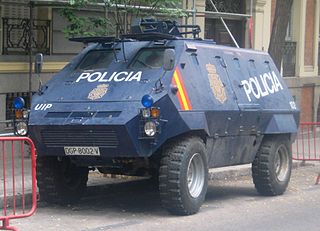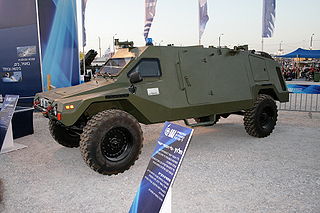
The Centurion was the primary British Army main battle tank of the post-World War II period. Introduced in 1945, it is widely considered to be one of the most successful post-war tank designs, remaining in production into the 1960s, and seeing combat in the front lines into the 1980s. The chassis was also adapted for several other roles, and these have remained in service to this day. It was a very popular tank with good armour, maneuverability, and gun.

The term Schwerer Panzerspähwagen, covers the six- and eight-wheeled armoured cars Germany used during the Second World War.

The Véhicule de l'avant blindé or VAB is an armoured personnel carrier and support vehicle designed by Renault of France. It entered service in 1976; around 5,000 were produced. As of 2019, it is the standard APC of the French Army and has also been exported to more than 15 countries. It saw combat in various conflicts in Africa, Asia and Europe.

The BRDM-2 is an amphibious armoured scout car used by Russia and the former Soviet Union. It was also known under the designations BTR-40PB, BTR-40P-2 and GAZ 41-08. This vehicle, like many other Soviet designs, has been exported extensively and is in use in at least 38 countries. It was intended to replace the earlier BRDM-1, compared to which it had improved amphibious capabilities and better armament.
The Light Armoured Vehicle II Coyote are armoured cars built by General Dynamics Land Systems Canada for the Canadian Forces. They are a later generation of the LAV-25 and of the same family as the Australian ASLAV, as all are part of the Light Armoured Vehicle family produced by General Dynamics Land Systems - Canada and based on the MOWAG Piranha 8x8.

The FV432 is the armoured personnel carrier variant in the British Army's FV430 series of armoured fighting vehicles. Since its introduction in the 1960s, it has been the most common variant, being used for transporting infantry on the battlefield. At its peak in the 1980s, almost 2,500 vehicles were in use.

The Royal Canadian Armoured Corps is the armoured corps within the Canadian Army, including 3 Regular and 18 Reserve Force regiments as well as the Royal Canadian Armoured Corps School.

The LAV III, originally named the Kodiak by the Canadian Army, is the third generation of the Light Armoured Vehicle (LAV) family of infantry fighting vehicles built by General Dynamics Land Systems – Canada (GDLS-C), a London, Ontario, based subsidiary of General Dynamics that first entered service in 1999. It was developed in Canada from the LAV II family and is the primary mechanized infantry vehicle of both the Canadian Army and the New Zealand Army. It also forms the basis of the Stryker vehicle used by the US Army and other operators.

The Fennek, named after the fennec, or LGS Fennek, with LGS being short for Leichter Gepanzerter Spähwagen in German, is a four-wheeled armed reconnaissance vehicle produced by the German company Krauss-Maffei Wegmann and Dutch Defence Vehicle Systems. The Turkish company FNSS Defence Systems acquired the right for licence production in 2004. It was developed for both the German Army and Royal Netherlands Army to replace their current vehicles.
A huge number of M113 Armored Personnel Carrier variants have been created, ranging from infantry carriers to nuclear missile carriers. The M113 armored personnel carrier has become one of the most prolific armored vehicles of the second half of the 20th century, and continues to serve with armies around the world in many roles.

The Rheinmetall LandSysteme Light Infantry Vehicle for Special Operations, or LIV (SO), is a German light armoured utility vehicle based on the Mercedes-Benz G-Class. It is also known by the names Serval, Wolf, and AGF. As the name implies, the LIV (SO) is designed specifically for use by special operations forces, and has light armour, high mobility and high firepower. Development of the vehicle started in 2002, and 21 were procured by the German Army for the KSK special forces in 2004. An unspecified number of vehicles were delivered to the Swiss Army in 2007.

The Dragoon 300 AFV was produced by Arrowpointe Corporation during the 1980s. It was based on the automotive components of the United States Army's M113 APCs and 5-ton trucks. It resembles a larger V-150 Commando.
Tanks of the Second World War

The Thyssen Henschel UR-416 is a German armoured personnel carrier, first introduced in 1969 and based on the body of the Mercedes-Benz Unimog light truck.

The Rhodesian Armoured Corps—the "Black Devils"—was the only standing armoured battalion of the Rhodesian Security Forces. During World War II, it took part in the Allied Spring 1945 offensive and the Battle of Monte Cassino as part of South Africa's 6th Armoured Division. The unit was among the first to enter a liberated Florence in July 1944. Prior to 1963, its crews were trained in the United Kingdom or Aden Colony and were known as the "Selous Scouts" under the Federation of Rhodesia and Nyasaland. After Rhodesia's Unilateral Declaration of Independence, maintaining the armoured vehicle fleet became a responsibility of the Rhodesian Light Infantry until Major Bruce Rooken-Smith reactivated the former Rhodesian Armoured Car Regiment in 1972. During the Rhodesian Bush War, the regiment fought in several major campaigns and battles, particularly Operation Miracle in September 1979. It was superseded by the new Zimbabwe Armoured Corps between 1980 and 1981.

The D-442 FUG and D-944 PSZH are the results of Hungarian domestic development of relatively cheap amphibious armoured scout car and armored personnel carrier series. FUG and PSZH were exported with limited success, thus it is also known under its Czechoslovak designation OT-65.

The Type 85 is a tracked armoured fighting vehicle produced by Chinese company Norinco. It is an improved version of the Type 63 armoured personnel carrier. The vehicle is bigger, has additional firing ports and periscopes, a longer chassis with an additional road wheel on each side, and is equipped with an NBC protection system.

Ordnance Factory Medak (OFMK), previously called Ordnance Factory Project Medak (OFPM) while in its development stage, is a company that manufactures armoured vehicles and is one of the 41 Indian Ordnance Factories under Ordnance Factories Board of the Ministry of Defence controlled by Government of India. It is spread over an area of 3023 acres and has an employee strength of about 3000 personnel. The company is headed only by an IOFS officer called General Manager who is the Chief Executive Officer responsible for the overall management of the company and is the main judicial authority. OFMK is the only manufacturer of Infantry Combat Vehicles (ICVs) in India.

The history and development of tanks in the Royal Canadian Armoured Corps can be broken down into smaller categories: their origin during World War I; the interwar period; World War II; the Cold War; and the modern era.

RAM MK3 is a light armored vehicle designed by IAI RAMTA. It is based on a 4×4 wheeled monocoque chassis.

















